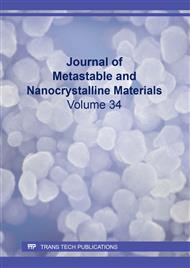[1]
E.M. Sahin, T. Tongur, E. Ayranci, Removal of azo dyes from aqueous solutions by adsorption and electrosorption as monitored with in-situ UV-visible spectroscopy, Sep. Sci. Technol., 55 (2019) 3287-3298.
DOI: 10.1080/01496395.2019.1676786
Google Scholar
[2]
H.C. Woo, S.H. Jhung, Adsorptive removal of nitro- or sulfonate- containing dyes by a functional metal-organic framework: Quantitative contribution of hydrogen bonding, Chem. Eng. J., 425 (2021) 130598.
DOI: 10.1016/j.cej.2021.130598
Google Scholar
[3]
S. Mallipudi, N.T. R. Lakshmi, M. Vangalapati, Removal of two azo and two anthra-quinone dyes from the textile effluent using tunic of Allium cepa, Int. j. innov., 2 (2013) 5622-5629.
Google Scholar
[4]
Y. Zhou, M. Zhang, X. Wang, Q. Huang, Y. Min, T. Ma, J. Niu, Removal of crystal violet by a novel cellulose-based adsorbent: Comparison with native cellulose, Ind. Eng. Chem. Res. 53 (2014) 5498–5506.
DOI: 10.1021/ie404135y
Google Scholar
[5]
B.M. Thamer, A. Aldalbahi, M. Moydeen, H. El-Hamshary, A.M. Al-Enizi, M.H. El-Newehy, Effective adsorption of Coomassie brilliant blue dye using poly(phenylene diamine)grafted electrospun carbon nanofibers as a novel adsorbent, Mater. Chem. Phys., 234 (2019) 133-145.
DOI: 10.1016/j.matchemphys.2019.05.087
Google Scholar
[6]
N.T. Abdel-Ghani, G.A. El-Chaghaby, E.S.A. Rawash, E.C. Lima, Adsorption of Coomassie Brilliant Blue R-250 dye onto novel activated carbon prepared from Nigella sativa L. waste: Equilibrium, kinetics and thermodynamics running title: Adsorption of Brilliant Blue dye onto Nigella sativa L. waste activated carbon, J. Chil. Chem. Soc., 62 (2017) 3505–3511.
DOI: 10.4067/s0717-97072017000200016
Google Scholar
[7]
M. Abbas, A. Cherfi, S. Kaddour, T. Aksil, Adsorption in simple batch experiments of Coomassie blue G-250 by apricot stone activated carbon—Kinetics and isotherms modelling, Desalin. Water Treat., 57 (2015) 15037–15048.
DOI: 10.1080/19443994.2015.1067871
Google Scholar
[8]
A.J.A. Magsino, C.J.T. Carlos, M.A.O. Torio, T.D.C. Villar, M.S. Rodriguez, M.J.B. Aguila, Removal of coomassie brilliant blue R-250 using iron oxide-graphene oxide composite via fenton-like reaction, Philipp J. Sci., 149 (2020) 1083-1094.
DOI: 10.56899/149.04.07
Google Scholar
[9]
M. Ishaq, U. Farooq, M. Salman, M.M. Athar, Catalytic reduction of coomassie brilliant blue R-250 by silver nanomagnetic cluster, J. mater. sci. eng., B 11 (2021) 28-41.
Google Scholar
[10]
M. Altikatoglu, M. Celebi, Enhanced stability and decolorization of coomassie brilliant blue R-250 by dextran aldehyde-modified horseradish peroxide, Artif Cell Blood Sustit Biotechnol., 39 (2011) 185-190.
DOI: 10.3109/10731199.2010.533124
Google Scholar
[11]
X. Qu, J. Brame, Q. Li, P.J.J. Alvarez, Nanotechnology for a safe and sustainable water supply: Enabling integrated water treatment and reuse, Acc. Chem. Res., 46 (2013) 834–843.
DOI: 10.1021/ar300029v
Google Scholar
[12]
R.N. Singh, Madhu, R. Awasthi, Alcohol Fuel Cells, Elsevier B.V., Amsterdam, (2013).
Google Scholar
[13]
G. Sharma, M. Naushad, A. Kumar, S. Rana, S. Sharma, A. Bhatnagar, F.J. Stadler, A.A. Ghfar, M.R. Khan, Efficient removal of coomassie brilliant blue R-250 dye using starch/poly(alginic acid-cl-acrylamide) nanohydrogel, Process Saf. Environ. Prot., 109 (2017) 301-310.
DOI: 10.1016/j.psep.2017.04.011
Google Scholar
[14]
R.S. Dassanayake, S. Acharya, N. Abidi, Recent advances in biopolymer-based dye removal technologies, Molecules, 26 (2021) 4697.
DOI: 10.3390/molecules26154697
Google Scholar
[15]
P. Semeraro, P. Fini, M. D'Addabbo, V. Rizzi, P. Cosma, Removal from wastewater and recycling of azo textile dyes by alginate-chitosan beads, Int. J. Environ. Agric. Biotechnol., 2 (2017) 1835–1850.
DOI: 10.22161/ijeab/2.4.48
Google Scholar
[16]
L. Cao, W. Lu, A. Mata, K. Nishinari, Y. Fang, Egg-box model-based gelation of alginate and pectin: A review, Carbohydr. Polym., 242 (2017) 1-15.
DOI: 10.1016/j.carbpol.2020.116389
Google Scholar
[17]
M. Rabisková, K. Dvoracková, L. Konfronová, Stability testing of alginate-chitosan films, Čes. slov. Farm., 61 (2012) 26-33.
Google Scholar
[18]
L. Fan, Y. Zhang, X. Li, C. Luo, F. Lu, H. Qiu, Removal of alizarin red from water environment using magnetic chitosan with alizarin red as imprinted molecules, Colloids Surf. B, 91 (2012) 250-257.
DOI: 10.1016/j.colsurfb.2011.11.014
Google Scholar
[19]
A. Shajahan, S. Shankar, V. Kaviyarasan, V. Narayanan, Adsorption efficacy of chitosan nanoparticles from Cunninghamella elegans on RBB dye, Proc. Int. Conf. Green Technol. Environ. Conserv., GTEC (2011) 238-243.
DOI: 10.1109/gtec.2011.6167675
Google Scholar
[20]
H. Tahir, A. Muhammad, U. Alam, R.B. Jamil, Q. Masooda, Structural modifications of surfactant-assisted alumina and their effectiveness for the removal of dyes, Iran. J. Chem. Chem. Eng., 37 (2018) 47-59.
Google Scholar
[21]
C.K. Jain, D.C. Singhal, M.K. Sharma, M.K., Adsorption of zinc on bed sediment of River Hindon: Adsorption models and kinetics, J. Hazard. Mater., 114 (2004) 231–239.
DOI: 10.1016/j.jhazmat.2004.09.001
Google Scholar
[22]
H. Rezaei, M. Haghshenasfard, A. Moheb, Optimization of dye adsorption using Fe3O4 nanoparticles encapsulated with alginate beads by Taguchi method, Adsorpt. Sci. Technol., 35 (2017) 55–71.
DOI: 10.1177/0263617416667508
Google Scholar
[23]
X. Chen, Modeling of experimental adsorption isotherm data, Inf., 6 (2015) 14–22.
Google Scholar
[24]
N. Ayawei, A.N. Ebelegi, D. Wankasi, Modelling and Interpretation of Adsorption Isotherms, J. Chem., (2017) 11-27.
DOI: 10.1155/2017/3039817
Google Scholar
[25]
R. Dubey, J. Bajpai, A.K. Bajpai, Chitosan-alginate nanoparticles (CANPs) as potential nanosorbent for removal of Hg (II) ions, Environ. Nanotechnology, Monit. Manag., 6 (2016) 32–44.
DOI: 10.1016/j.enmm.2016.06.008
Google Scholar
[26]
R.H. Ramli, C. Fhong Soon, A.Z. Mohd Rus, Synthesis of Chitosan/Alginate/Silver Nanoparticles Hydrogel Scaffold, MATEC Web Conf., 78 (2016) 1–8.
DOI: 10.1051/matecconf/20167801031
Google Scholar
[27]
N.M. Mahmoodi, B. Hayati, M. Arami, H. Bahrami, H., Preparation, characterization and dye adsorption properties of biocompatible composite (alginate/titania nanoparticle), Desalination, 275 (2011) 93–101.
DOI: 10.1016/j.desal.2011.02.034
Google Scholar
[28]
G. Ozturk, H. Silah, Adsorptive removal of remazol brilliant blue R from water by using a macroporous polystyrene resin: isotherm and kinetic studies, Environ. Process., 7 (2020) 479-492.
DOI: 10.1007/s40710-020-00429-4
Google Scholar
[29]
Ngatijo, E. Permana, L.P. Yanti, B. Ishartono, R. Basuki, Remazol brilliant blue uptake by green and low-price black carbon from ilalang weeds (Imperata cylindrica) activated by KOH solution, JKPK, 6 (2021) 192-205.
DOI: 10.20961/jkpk.v6i2.53113
Google Scholar
[30]
S. Dhananasekaran, R. Palanivel, S. Pappu, Adsorption of methylene blue, bromophenol blue, and coomassie brilliant blue by α-chitin nanoparticles, J. Adv. Res., 7 (2016) 113-124.
DOI: 10.1016/j.jare.2015.03.003
Google Scholar
[31]
J. Wang, X. Guo, Adsorption kinetic models: Physical meanings, applications, and solving methods, J. Hazard. Mater., 390 (2020) 1–18.
Google Scholar



